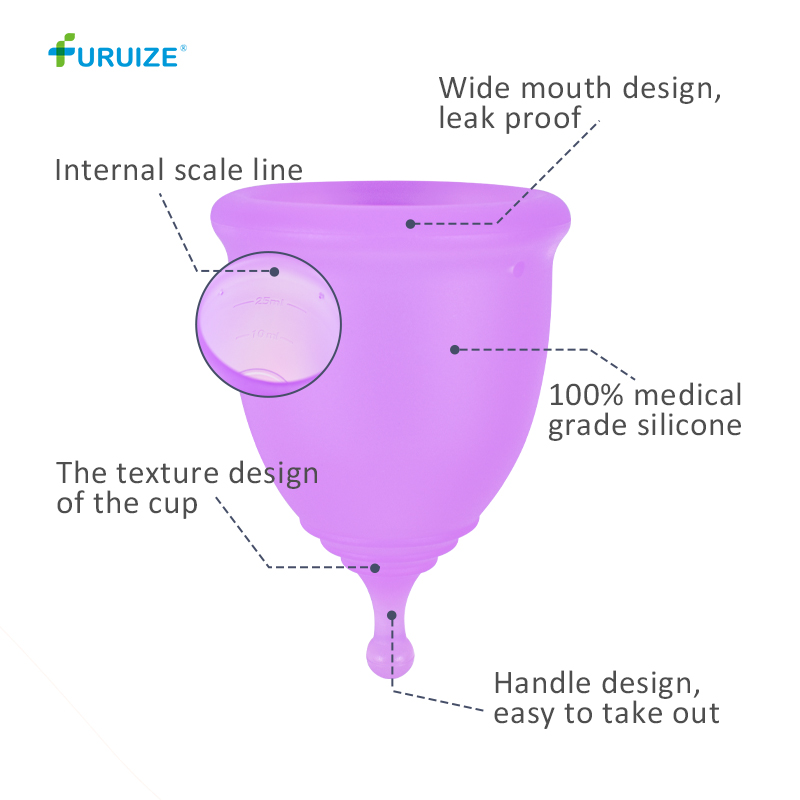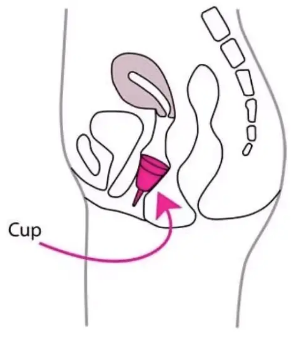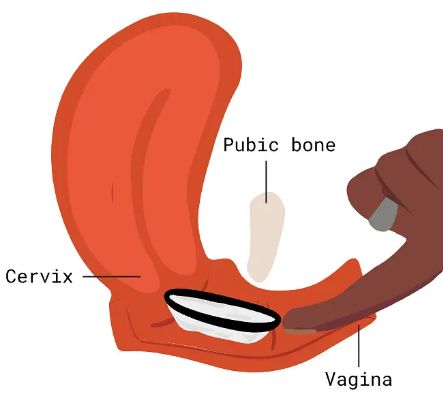FuruizeCup
Menstrual cups and menstrual discs sound very similar. And they are both reusable feminine hygiene products, that is, they are both your choices if you don’t want to use tampons or pads. But they also have some major differences, like design and usage. To help us know more about menstrual discs vs. cups, we break it down for you here, let’s get started:
What is a menstrual cup?
The menstrual cup is bell or cup shaped (typically with a stem), and uses a seal to stay in place within the vaginal canal, in roughly the same area a tampon is worn. It is inserted into the vagina during menstruatiaon to capture menstrual blood. Most menstrual cups have holes around the rim which allow the cup to create light suction and stay secure within the vaginal canal. It forms a seal with the vaginal walls, preventing leaks. A menstrual cup can be worn for up to 12 hours and can hold anywhere from 2-4 tampons worth of fluid depending on what size cup is being used. Most menstrual cups are made from 100% medical-grade silicone and are reusable. They can be emptied, washed, and reused throughout a woman’s menstrual cycle. High-quality cups like Furuize menstrual cups can last up to 5 years with proper use and care.
What is a menstrual disc?
Menstrual discs are available in both reusable and disposable versions. Reusable menstrual discs like the Furuize Disc are made of 100% medical-grade silicone, can be worn for up to 12 hours, and can last up to 10 years with proper use and care. Unlike menstrual cups, which sits lower in the vaginal canal, menstrual discs are disc-shaped and are positioned at the vaginal fornix, which is higher up. A menstrual disc uses no suction to stay securely behind the pubic bone. Menstrual discs often have a higher capacity than menstrual cups, holding up to 3-6 tampons worth of fluid, or 30-50 mL. Menstrual discs have a different insertion and removal process compared to cups and may be more comfortable for some users due to their placement. Additionally, menstrual discs can be worn for no-mess period sex.
What are the differences between cups and discs?
While they appear at first glance to be very similar they are quite different in some very important ways.
1. Design and Placement:
Menstrual Cups:
Menstrual cups are inserted into the vaginal canal, creating a seal against the vaginal walls. The cup collects menstrual fluid, preventing leaks and offering reliable protection. The placement of menstrual cups is lower in the vaginal canal compared to discs, making them easily accessible for insertion and removal.
Menstrual Discs:
Menstrual discs are positioned higher in the vaginal canal, specifically at the vaginal fornix. This design allows the disc to collect menstrual fluid closer to the cervix, offering potential advantages in mess-free intimacy. The disc sits horizontally in the body, covering the cervix and preventing leaks.
2. Material Composition:
Menstrual Cups:
Menstrual cups are commonly made from medical grade silicone, rubber, latex, or elastomer. These materials are chosen for their flexibility, durability, and biocompatibility. Users with latex sensitivities can opt for cups made from alternative materials. The quality of materials ensures that cups are safe for extended wear and do not pose health risks.
Menstrual Discs:
Similar to menstrual cups, menstrual discs are often made from medical grade materials, including silicone or thermoplastic elastomer (TPE). The materials used are hypoallergenic and safe for internal use. Some discs are designed for single-use and are disposable, while others are made for multiple uses, contributing to environmental sustainability.
3. Usage and Capacity:
Menstrual Cups:
Menstrual cups come in various sizes and capacities to accommodate different users. They are available in smaller sizes for those with lighter flows,
and larger sizes for those with heavier flows or who have given birth. Cups can typically hold more menstrual fluid than tampons, making them suitable
for longer wear, including overnight.
Menstrual Discs:
Menstrual discs also vary in size, but their capacity may be influenced more by their design and how they collect fluid. The disc’s position near the cervix
allows it to collect fluid at a higher point in the vaginal canal, potentially providing a larger overall capacity compared to some cups. This can be
advantageous for individuals with heavier flows.
4. Insertion and Removal:
Menstrual Cups:
Inserting and removing a menstrual cup involves folding the cup for insertion and allowing it to unfold inside the vaginal canal. Removal requires
gently pulling on the stem, breaking the seal, and then emptying the cup. While some users may find the process straightforward, others might need
time to become accustomed to the technique.
Menstrual Discs:
Inserting a menstrual disc involves a different process. Users need to position the disc correctly at the vaginal fornix, ensuring it covers the cervix.
Removal requires sliding a finger behind the disc’s edge to break the seal before taking it out. The removal process might have a steeper learning
curve for some users due to the disc’s unique placement and orientation.
5. Comfort and Learning Curve:
Menstrual Cups:
Many users appreciate the comfort of menstrual cups once they become accustomed to the insertion and removal process. The learning curve varies
among individuals, with some adapting quickly and others requiring more time. Choosing the right size and shape is crucial for optimal comfort and
effectiveness.
Menstrual Discs:
The comfort of menstrual discs is influenced by their higher placement and horizontal orientation. Some users find that discs are more comfortable
during certain activities, such as intercourse, due to their design. However, the learning curve for insertion and removal may be higher, and users
might need more practice to feel confident using discs.
6. Sustainability:
Menstrual Cups:
One of the key advantages of both menstrual cups and discs is their sustainability. Menstrual cups are reusable and can last for several years with
proper care. This reduces the environmental impact associated with disposable menstrual products, contributing to a more eco-friendly menstrual
care routine.
Menstrual Discs:
Reusable menstrual discs also contribute to sustainability. However, it’s important to note that some discs are designed for single-use, leading to
more waste. Users interested in minimizing their environmental footprint should opt for reusable discs that can be washed and reused for an
extended period.
7. Cost Considerations:
Menstrual Cups:
While the initial cost of a menstrual cup may be higher than disposable products, the long lifespan and reusability make them cost-effective over time.
Users can save money by not continuously purchasing disposable pads or tampons.
Menstrual Discs:
The cost of menstrual discs varies, with reusable options being more cost-effective in the long run. Disposable discs, however, might incur ongoing
expenses if used regularly. Users should consider their budget and environmental priorities when choosing between reusable and disposable options.
Conclusion:
In conclusion, both menstrual cups and menstrual discs offer innovative alternatives to traditional menstrual products. The choice between them
depends on individual preferences, comfort levels, and lifestyle considerations. Users should consider factors such as design, placement, material,
usage, comfort, sustainability, and cost when making a decision. Ultimately, finding the right menstrual care product involves a degree of experimentation
to determine which option aligns best with individual needs and preferences. As these products continue to evolve, users can look forward to a wider
array of choices that cater to diverse menstrual care preferences.
If they’re different, which is best?
Choosing between a menstrual cup and a menstrual disc depends on personal preferences and factors such as your anatomy, lifestyle, and comfort. Here are some considerations:
For Menstrual cup:
- Size and Shape: Cups come in various sizes and shapes. Consider your age, flow, and whether you’ve given birth when selecting a size.
- Material: Choose a cup made from medical-grade silicone, rubber, latex, or elastomer based on any material sensitivities.
- Comfort:Some people prefer the comfort and familiarity of a cup, especially if they are used to internal menstrual products.
For Menstrual Discs:
1. Placement: Menstrual discs sit higher in the vaginal canal, making them potentially suitable for mess free intimacy. Consider whether this aligns with your lifestyle and preferences.
2. Disposable vs. Reusable: Menstrual discs are available in both disposable and reusable options. Choose based on your preference for convenience or sustainability.
3. Learning Curve: Menstrual discs may have a steeper learning curve due to their unique insertion and removal process. Consider your comfort level with trying a new technique.
General Tips:
– Trial and Error: It might take some experimentation to find what works best for you. Consider starting with a smaller size or trying a variety pack.
– Seek Advice: Consult with experienced users or healthcare professionals for guidance. Online forums and reviews can provide valuable insights.
– Consider Your Lifestyle: Think about your daily activities, including sports or any other physical activities, as this might influence your choice.
Remember that individual preferences vary, and what works for one person may not work for another. If you’re uncertain, it’s advisable to seek advice from those experienced with these products or consult a healthcare professional.
FURUIZE
Share this entry
Lorem ipsum dolor sit amet, consectetur adipiscing elit.
Click here to add your own text







